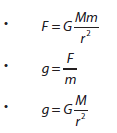| Nature of science: Laws: Newton’s law of gravitation and the laws of mechanics are the foundation for deterministic classical physics. These can be used to make predictions but do not explain why the observed phenomena exist. (2.4) | |
Understandings:
Applications and skills:
Guidance:
Data booklet reference:
|
Theory of knowledge:
Utilization:
Aims:
|


